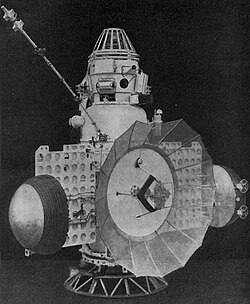Original design (1963-1965)
The probe consisted of three primary parts.
Orbital Compartment
The core of the stack was a pressurized compartment called the Orbital Compartment. This part housed the spacecraft's control electronics, radio transmitters and receivers, batteries, astro-orientation equipment, and so on. The compartment was pressurized to around 100 kPa and thermally controlled to simulate earth-like conditions, which removed the need for special electronic components that could reliably operate in extreme conditions (on Zond 1 the module depressurized in flight, severely damaging the probe's systems).

Mounted on the outside of the Orbital Compartment were two solar panels which supplied power to the spacecraft. They were folded against the body of the probe during launch and were only deployed when the craft was already on its interplanetary trajectory. On the ends of each solar panel was a hemispherical radiator which radiated excess heat from the orbital compartment into space through a coolant loop.
Also mounted on the Orbital Compartment was a 2 m parabolic high-gain antenna, used for long-range communications. Depending on the mission, the probe also used other antennas (for example, for communication with probes on the planet's surface).
Planetary Compartment
Below the Orbital Compartment was a second pressurized compartment called the Planetary Compartment. Depending on the mission the Planetary Compartment either housed scientific equipment for orbital observation of the planet or was designed to detach and land on the planet's surface.
Engine
Course correction capabilities were provided by a KDU-414 engine attached to the top of the Orbital Compartment. It provided a maximum thrust of around 2 kN and used UDMH and nitric acid as propellants. Attitude control was achieved by several small cold gas thrusters.
The whole stack was 3.6 m high and weighted around 1000 kg.
